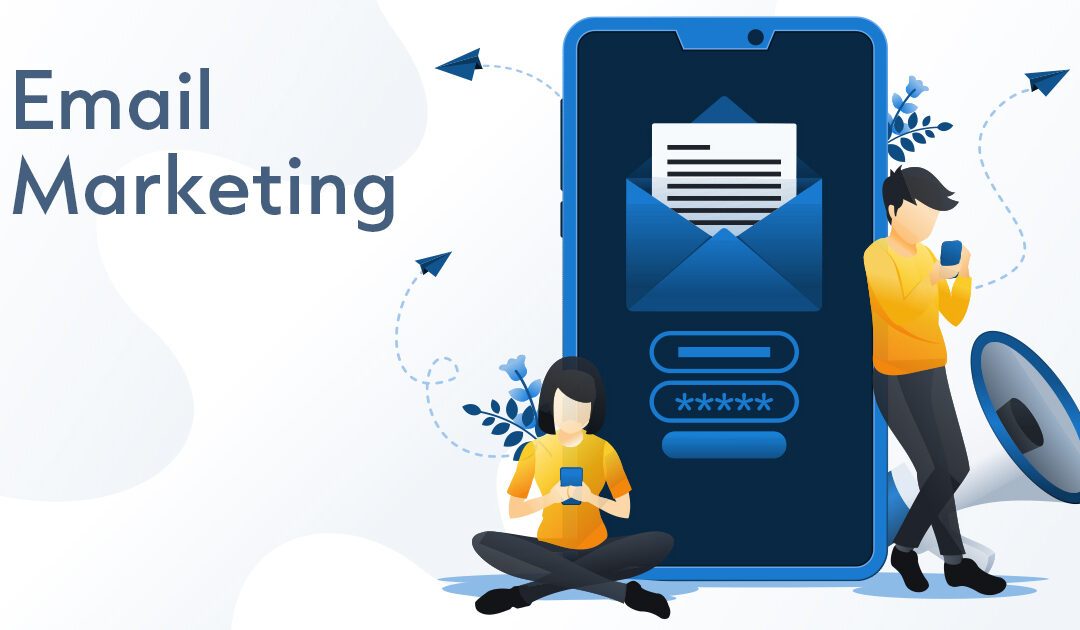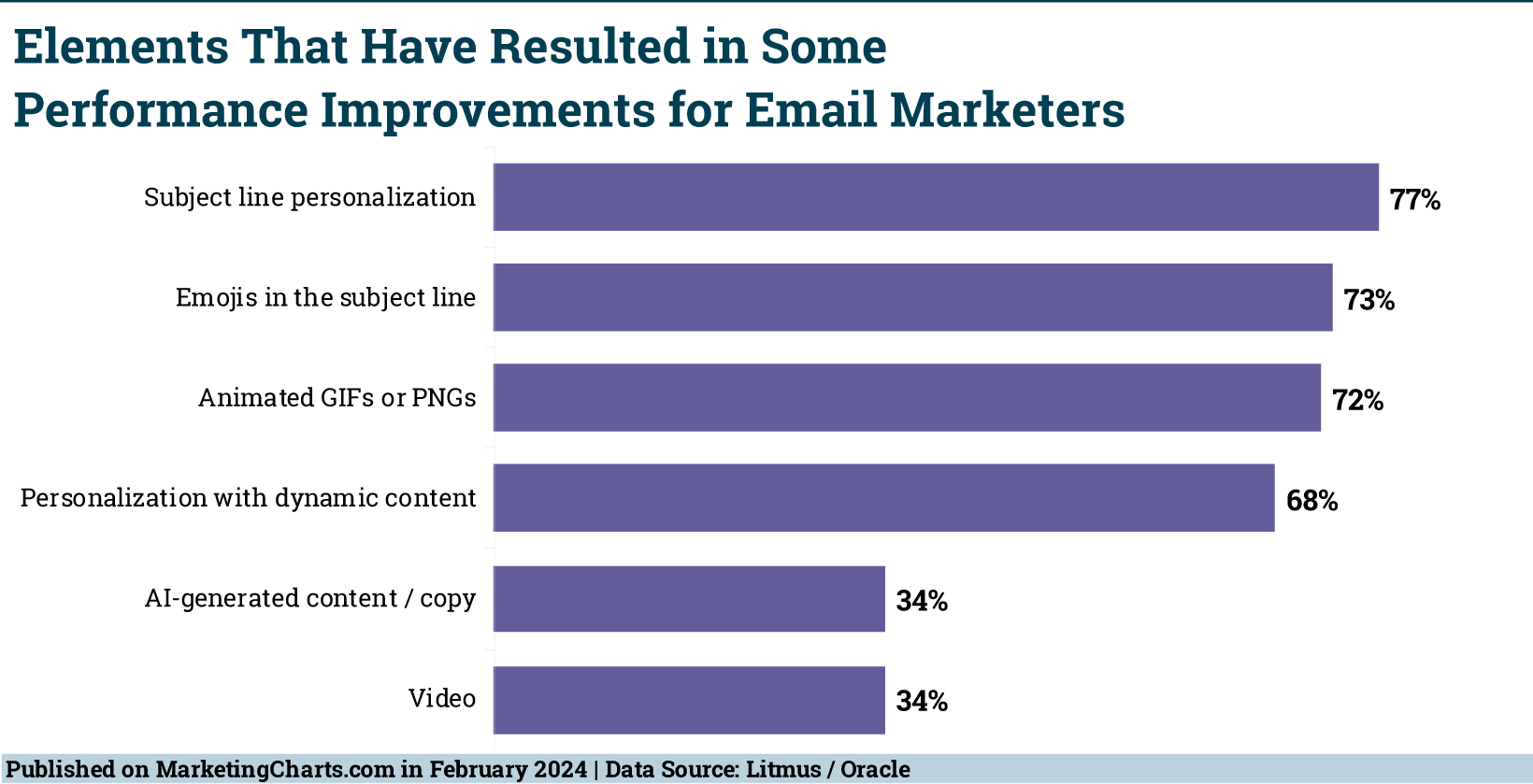
by Lori Berson | Apr 3, 2024 | Email Marketing, Marketing
Email marketing remains a vital tool for businesses aiming to connect with their audience. However, the effectiveness of this tool is significantly influenced by how businesses choose to use artificial intelligence (AI) and personalization tactics. A recent Litmus report in partnership with Oracle provides an overview of the current landscape and the opportunities available with email marketing, revealing some insightful trends.

AI in Email Marketing: Underused Yet Potentially Transformative
AI-generated content and copy in email marketing, despite being a common use case, surprisingly ranks low in contributing to campaign performance improvements. This apparent underutilization is not a reflection of AI’s potential but rather indicates a nascent stage of adoption. With only one-third of marketers reporting a boost in email performance due to AI-generated content, it’s clear that those who have used generative AI are reaping significant benefits. This scenario presents a compelling opportunity for businesses to explore AI’s capabilities further and integrate them into their email marketing strategies.
The Unrivaled Impact of Personalization and Segmentation
The report highlights two critical tactics that overwhelmingly improve email marketing performance: subject line personalization and the use of emojis. An impressive 77% of email marketers have found that personalizing subject lines enhances campaign effectiveness, while 73% credit emojis with boosting performance. This data underscores the importance of crafting engaging and tailored content that resonates with the recipient, making the email more than just another message in their inbox but a personalized communication that captures their attention.
Beyond subject lines, personalization extends into the content of the emails themselves. Dynamic content, tailored to the recipient’s preferences and behaviors, has significantly increased click-through rates. This level of customization demonstrates a deep understanding of the target audience, making for a stronger connection between the brand and its customers.
Furthermore, an overwhelming 90% of surveyed email marketers acknowledged that segmentation plays a pivotal role in enhancing campaign performance. By dividing their audience into distinct groups based on specific criteria, marketers can deliver more relevant and impactful messages, thereby increasing engagement and conversion rates.
A Call to Action
The insights from the Litmus and Oracle report serve as a compelling call to action for email marketers. In an age where consumers are bombarded with digital communications, the ability to stand out through personalized, engaging, and AI-enhanced content is more crucial than ever. As email marketing continues to evolve, businesses must stay updated on these trends and leverage them to create meaningful connections with their audience. By prioritizing personalization, segmentation, and the strategic use of AI, marketers can transform their email campaigns into powerful tools for building lasting relationships and driving business success.
About the Data: The results are based on an October and November 2023 survey of more than 480 email marketers worldwide.
For help with your email marketing, schedule a call or email Lori Berson at lberson@BersonDeanStevens.com.
BersonDeanStevens has been a recognized brand strategy and marketing leader for over 25 years. We work in partnership with you to differentiate your brand and achieve your business goals. Client list.

by Lori Berson | Mar 20, 2024 | Marketing, Marketing Strategy
Are you looking for an exciting way to grab your audience’s attention and keep them hooked? Gamification marketing might be the solution! By turning ordinary experiences into captivating games, you can boost engagement, motivation, and ultimately, success.
What Exactly Is Gamification Marketing?
Gamification marketing brings the thrill of gaming into everyday situations, making them more engaging and rewarding. It taps into our natural love for achievements, competition, and incentives, transforming mundane activities into enjoyable adventures that keep people glued.
Imagine spicing up your marketing campaigns with leaderboards, progress bars, quests, and rewards. These game-inspired elements allow marketers to create interactive experiences that audiences can’t resist.
For example, a leaderboard could showcase the top performers, fueling some friendly rivalry. Progress bars provide a visual representation of advancement, motivating users to conquer tasks and milestones. Exciting quests or challenges give participants goals to chase, while rewards like exclusive benefits or virtual goods drive motivation.
When brands blend these gamification examples into their strategies, they foster stronger bonds with their target audiences. Customers become active participants in the brand experience, feeling a sense of accomplishment as they progress through challenges or compete against others. This boosts brand loyalty, attention spans, and desired outcomes like increased sales, user retention, or better learning.
Gamification Marketing in Action
This engaging approach has found success across various industries and platforms. From the Starbucks Rewards program, rewarding purchases with points and status levels, to language apps like Duolingo using badges and leaderboards to make learning addictive – the possibilities are limitless.
Nike’s Run Club app is a prime example, turning fitness tracking into an interactive game complete with badges, challenges, and personalized training programs that level up. Even quirky campaigns like KFC’s “Colonel Sanders’ Dating Simulator” gamified their brand by letting players learn about menu items through an amusing storyline. Even a trivia contest from brands like Coke or Pepsi can work – correctly answering questions earns you prizes.
At its core, gamification marketing harnesses our natural desires and habits, transforming marketing initiatives into immersive experiences that captivate and motivate. By incorporating game-inspired elements, marketers can elevate their strategies, creating lasting impressions and strengthening audience connections.
Keys to Gamification Marketing Success
Implementing an effective gamification strategy requires careful planning aligned with your business goals and target audience.
Here are some key steps:
- Define clear objectives – Increased engagement? Loyalty? Improved learning? Pinpoint the outcomes you want to achieve.
- Know your audience – Understand their preferences, motivations, and pain points to design compelling game elements.
- Choose the right game mechanics – Leaderboards, progress bars, quizzes, badges, virtual currencies – select those that best fit your goals and audience. Low-cost apps are available to help manage the process like Gametize, PUG Interactive, Funifier, Scavify, Treehouse, Fitocracy, Influitive, and others.
- Integrate seamlessly – Introduce gamified experiences across your platforms like websites, apps, and social media for a consistent experience.
- Offer enticing incentives – Rewards like exclusive access, discounts, or virtual goods will encourage continuous participation.
- Analyze performance – Use analytics and feedback to measure impact on metrics like user retention and optimize your strategy.
Gamification marketing is a potent tool for creating captivating, enjoyable experiences that drive desired behaviors from your audience. Incorporate leaderboards, quests, and rewards and you’ll see boosted engagement, motivation, and better results.
To level up your marketing game with gamification and unlock customer loyalty, online learning, brand awareness, and more, schedule a call or email Lori at lberson@BersonDeanStevens.com.
For help with adding gamification to your marketing, schedule a call or email Lori Berson at lberson@BersonDeanStevens.com.
BersonDeanStevens has been a recognized brand strategy and marketing leader for over 25 years. We work in partnership with you to differentiate your brand and achieve your business goals. Client list.

by Lori Berson | Feb 28, 2024 | Marketing, Marketing Strategy
In today’s rapidly shifting business landscape, the relationship between Chief Executive Officers (CEOs) and their marketing counterparts has entered a phase of renewed confidence and heightened expectations. According to the latest insights from the third annual CEO Study on Marketing and the CMO by Boathouse, there’s a notable uplift in how CEOs perceive the performance of their marketing leaders and teams.

Rising Confidence in Marketing Leadership
A striking aspect of the study is the growing confidence CEOs have in their CMOs. An impressive 26% of surveyed CEOs from top US companies awarded their CMOs an “A” grade for overall performance, a substantial increase from 16% the previous year. Furthermore, 40% of CEOs now consider their CMO to be “best in class,” marking a significant rise from previous years. This upward trend in confidence extends to the marketing function as a whole, with nearly half (49%) of the CEOs rating their marketing capabilities as “best in class,” a notable leap from just 24% the year before.
The Bottom Line: Growth and Revenue
But what has contributed to this surge in confidence? At its core, the answer revolves around the bottom line—growth and revenue. CEOs are increasingly looking to their marketing teams to solve critical challenges centered around these areas. The primary task? To create and retain customers to drive revenue growth. This mandate remains a cornerstone of marketing’s role, reflecting its pivotal contribution to a company’s financial success.
CEOs have laid out clear priorities for their marketing teams, emphasizing the need to drive sales, grow market shares, and outpace the competition. These goals highlight the strategic importance of marketing in not only attracting customers but also in defining a company’s standing in the market.
Branding and Narrative: More Than Just Revenue
However, it’s not all about revenue and market share. CEOs also prioritize brand-related objectives, such as improving brand reputation (41%) and transforming the company’s narrative in the marketplace (40%). This aligns with the broader understanding that a strong brand and reputation are intertwined and crucial for long-term success.
Beyond the Traditional: Social Impact and Innovation
Despite their focus on growth and branding, CEOs are also aware of the broader role marketing can play. Areas such as social impact, investor perception, and product innovation, though not ranked as top priorities, are still on the CEO’s radar. This acknowledgment points to a nuanced understanding that, while growth and revenue are paramount, long-term success also depends on innovation, social responsibility, and effective communication with investors.
This evolving CEO perspective signals a shift towards recognizing the multifaceted role of marketing in driving not just traditional outcomes like sales and brand awareness but also in shaping the company’s strategic direction and growth. As marketing teams continue to rise to these challenges, their alignment with the CEO’s vision will be critical in navigating the complexities of today’s business landscape and achieving sustained success.
About the Data: The results are based on an October 2023 survey of 150 CEOs from top US companies with at least $250 million in annual revenues. The question about the top problems that CEOs want marketing to solve was answered by half of the sample.
For help with your marketing, schedule a call or email Lori Berson at lberson@BersonDeanStevens.com.
BersonDeanStevens has been a recognized brand strategy and marketing leader for over 25 years. We work in partnership with you to differentiate your brand and achieve your business goals. Client list.

by Lori Berson | Feb 26, 2024 | Marketing, Marketing Strategy, Social Media
In the evolving world of social media, keeping up with platform popularity and usage trends is essential for marketers, content creators, and users alike. It has become an integral part of our daily lives, shaping the way we connect, share, and consume information.
A recent Pew Research Center study reveals the current state of social media platform use among US adults, and offers valuable insights into demographic preferences and platform adoption rates.

YouTube Leads The Pack
YouTube continues to dominate as the most widely used social media platform for a diverse audience, with an impressive 83% of US adults tuning into the watch videos. This marks a slight increase from 2021, signaling YouTube’s enduring appeal across various demographic groups. Interestingly, its popularity spans across genders, with both men (82%) and women (83%) nearly equally engaged. Multicultural groups, particularly English-speaking Asian (93%) and Hispanic (86%) adults, show higher adoption rates, highlighting YouTube’s broad reach.
The platform’s appeal is not limited to younger audiences; while 93% of 18-29-year-olds are avid YouTube viewers, the platform also enjoys high engagement rates among 30-49-year-olds (92%) and has seen a significant uptick in usage among those 65 and older, climbing from 38% in 2019 to 60%. Income and education levels also play a role in YouTube’s popularity, with higher rates of adoption among those in the top income bracket and with higher educational attainment.
Facebook’s Steady Presence
Despite fluctuating trends in social media, Facebook maintains a consistent user base, with 68% of survey respondents reporting usage. While its adoption is higher among women (76%) than men (59%), Facebook’s usage trends vary significantly across age groups, showing a decline among younger adults and a rise in usage among those aged 65 and older.
Instagram’s Growing Appeal
Instagram’s user base is on the rise, reaching 47% of adults, up from 40% in 2021. The platform’s visual nature and dynamic content seem to resonate more with women (54%), Hispanic (58%), and Asian adults (57%), suggesting its particular appeal among these groups. Younger adults (18-29) remain the most engaged, with a significant 78% using Instagram, pointing to its stronghold among the youth.
Pinterest’s Unique Demographic Skew
Pinterest, known for its inspiration-driven content, shows a unique demographic pattern, with significantly higher usage among women (50%) than men (19%). It also stands out for its slightly higher adoption rate among rural adults (36%) compared to urban counterparts (31%), suggesting its appeal across different living environments.
TikTok’s Rapid Rise
TikTok has seen explosive growth, with 33% of US adults using the platform, up from 21% in 2021. The app’s engaging content format appears to be particularly popular among women (40%), Hispanic (49%), and Black (39%) adults. Its highest usage among the youngest adults (18-29) at 62% underscores TikTok’s role as a key player in shaping social media trends.
LinkedIn and WhatsApp: Platforms for Professional and Personal Connections
LinkedIn and WhatsApp each cater to specific needs, with LinkedIn maintaining a steady 30% usage among adults, predominantly among higher-income and educated demographics. WhatsApp, on the other hand, has seen growth to 29% of adults, with notable popularity among Hispanic adults (54%), illustrating its importance in keeping personal and professional networks connected.
Other Platforms and Trends
Snapchat and Twitter/X maintain steady but distinct user bases, with Snapchat being more popular among younger users and Twitter/X showing broader use among higher-income and more educated adults.
Reddit’s popularity continues to rise, especially among men and the 18-29 age group, reflecting broader trends in social media where platforms cater to specific interests and demographics.
BeReal, while newer to the scene, shows potential for growth, particularly among younger adults and women, though its overall adoption remains low.
Implications for Marketers and Content Creators
Understanding these trends is crucial for anyone looking to engage with audiences effectively on social media. The data highlights the importance of tailoring content and strategies to specific platforms and demographic groups to maximize reach and impact. As social media continues to evolve, staying informed about these trends will be key to navigating the digital landscape successfully.
About the Data: The results are based on a May-September 2023 survey of 5,733 US adults (18+).
For help with your social media marketing, schedule a call or email Lori Berson at lberson@BersonDeanStevens.com.
BersonDeanStevens has been a recognized brand strategy and marketing leader for over 25 years. We work in partnership with you to differentiate your brand and achieve your business goals. Client list.

by Lori Berson | Feb 20, 2024 | Digital marketing, Lead Generation, Marketing, Marketing Strategy
According to the study by Integrate Pipeline360 and Demand Metric, B2B marketers are increasingly relying on paid social media and email marketing to generate leads, reflecting a strategic shift towards digital channels that offer measurable results and targeted outreach. This focus is driven by the dual objectives of improving lead quality and increasing lead volume, challenges that are top of mind for marketers aiming to enhance their sales pipeline and drive business growth.

However, the quest for more leads doesn’t always end with choosing the right channels. It extends into optimizing these channels to ensure that the leads generated are not only numerous but also of high quality. This is where the complexity of digital marketing becomes evident, as marketers must navigate the nuances of content creation, audience targeting, and data analysis to achieve their lead generation goals effectively.
For companies looking to navigate the complexities of lead generation in this digital age, BersonDeanStevens, Inc. (BDS) offers expertise in crafting and executing lead generation strategies that are tailored to the unique needs of B2B marketers. With a deep understanding of digital marketing trends and the challenges faced by marketers today, BDS is positioned to help businesses enhance their lead generation efforts, ensuring a steady flow of high-quality leads. For those looking to elevate their lead generation strategies and drive meaningful business results, contact BDS for expert guidance and support.
About the Data: The results are based on a November 2023 survey of 437 marketers in the US (50% share) and UK (46%) working at companies targeting B2B (58%) or B2B and B2C (42%) channels.
For help with your lead generation, schedule a call or email Lori Berson at lberson@BersonDeanStevens.com.
BersonDeanStevens has been a recognized brand strategy and marketing leader for over 25 years. We work in partnership with you to differentiate your brand and achieve your business goals. Client list.

by Lori Berson | Feb 14, 2024 | Content Marketing, Marketing, Marketing Strategy
Gone are the days of text-heavy blog posts that leave your audience hungry for more. To captivate and engage in today’s digital landscape, you need to serve up an irresistible all-you-can-eat content buffet that’s not only high-quality but also innovative and engaging. This means breaking away from traditional formats and exploring new, creative ways to capture your audience’s attention.
Let’s explore the essential ingredients marketers can use to satisfy and delight their audience.
Visuals: Tantalizing the Eyes and Appetite
Forget boring stock photos. Whet their appetite with mouthwatering visuals like infographics, charts, videos, gifs, original graphics, and even AI-generated imagery. These eye-catching elements can transform your content from bland to brilliant and make complex information more digestible while adding flavorful brand flair.
With user-friendly tools like Canva and Adobe Express (both offer free versions), anyone can cook up amazing visuals.
Podcasts: Audio Amuse-Bouches
Podcasts are soaring in popularity, offering an intimate, screen-free way to connect with your audience. Strategically sprinkle podcast episodes across your menu to build brand awareness and deliver value through stories, educational content, discussions, and industry insights. These AI tools make it simple to turn text into captivating podcasts: Wondercraft, Riverside, and Adobe Podcast.
Remember to promote new episodes through email, newsletters, social media, and your blog for a multi-channel approach.
Interactive Content: Letting Your Audience Sample the Goods
Interactive content invites your audience to actively participate in the experience. Quizzes, games, calculators, image sliders, AR filters, interactive videos, and other digital tools provide value while capturing contact info.
For example, an interactive calculator provides personalized data guiding users through their buying journey while keeping them engaged. To get started, check out Okendo, Quizgecko, and Meiro.
User-Generate Content (UGC): Customer-Crafted Signatures
User-generated content offers authenticity and community. Highlight UGC-like social shares, video testimonials, and reviews to show you value your clients while improving engagement. Some easy-to-use tools include GatherUp, Boast, and TrustPilot.
Time To Dine on Captivating Content!
Like an artful chef, captivating content requires the right blend of visuals, audio, interactive elements, and UGC artfully presented across channels. Serve up your audience a journey that informs, entertains, and provides value. Do this, and your content will leave them satisfied and eager to come back for more.
For help with your content strategy and marketing, schedule a call or email Lori Berson at lberson@BersonDeanStevens.com.
BersonDeanStevens has been a recognized brand strategy and marketing leader for over 25 years. We work in partnership with you to differentiate your brand and achieve your business goals. Client list.









